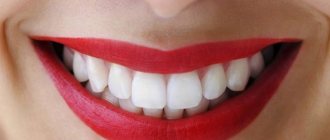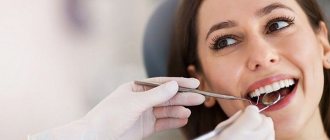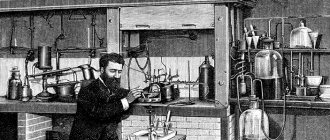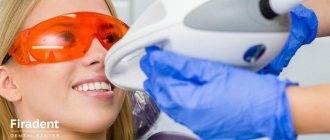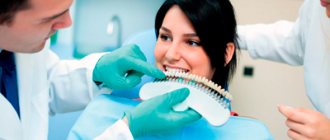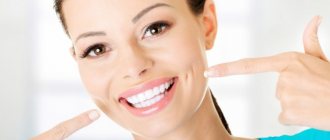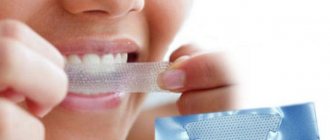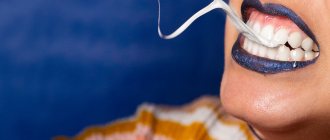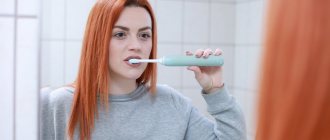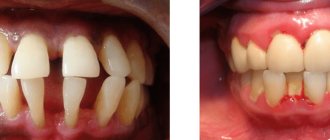How does baking soda affect teeth?
Soda is a good and inexpensive disinfectant. Even now, doctors recommend using it in dental treatment of infants who are diagnosed with stomatitis or oral thrush.
Soda kills fungus and promotes rapid healing of ulcers on the mucous membrane that appear as a result of stomatitis due to its high regenerative properties. In addition, sodium bicarbonate has a pronounced anti-inflammatory effect. Dentists often prescribe rinses or baths with soda or soda-saline solution for purulent periodontitis and pulpitis, after opening the cavity of the affected tooth.
In America, clinical observations of the oral health of patients using soda pastes for brushing their teeth and microbiological analyzes of the contents from the oral cavity of these patients showed that the concentration of pathogenic microorganisms is significantly reduced.
Whitening effect of brushing teeth with baking soda
As for hard tooth tissues, soda has a good whitening effect . The enamel is lightened by at least 0.5 shades, which can be compared with professional oral hygiene. This happens thanks to abrasive particles that efficiently clean the tooth surface from dental plaque and food debris. Conventionally, you can compare brushing your teeth with soda to cleaning various surfaces with sandpaper.
American scientists even conducted a study in 2008 that showed that pastes based on baking soda are much better at removing dental plaque than pastes with a soda-free composition or a low concentration.
It is necessary to take into account the fact that soda is a pure abrasive. Abrasive particles are found in many toothpastes, especially whitening ones. Dentists do not recommend using whitening toothpastes for longer than 2 weeks, because... abrasive particles can thin the enamel layer of the tooth, leading to hypersensitivity. For this reason, pure abrasive in the form of baking soda definitely cannot be used often . Dentists also do not recommend using soda in dry, undiluted form.
You also need to pay attention to the pH of the soda. It is equal to 8, which is typical for an alkaline environment. Many people are afraid of this indicator, but it is only dangerous for the protective barrier of the skin, which is manifested by redness around the mouth if soda pastes act on the skin for a long time. For the oral cavity, an alkaline environment, on the contrary, is positive, because it neutralizes acidity. It is high acidity that contributes to the destruction of hydroxyapatites in the enamel, which act as a kind of skeleton, thereby disrupting the structure of hard tissues and provoking the development of caries and its complications in the future.
Soda teeth whitening:
The benefits and harms of cleaning
Only baking soda is suitable for teeth!
The advantages of sodium bicarbonate pastes include:
- Achieving a positive result quickly, the enamel becomes lighter after the first procedure.
- Easy to prepare pasta and use it.
- Removal of all dental plaque.
- Low cost.
- Relief of unpleasant odor from the oral cavity.
- Relief of inflammatory processes in the oral cavity.
- Accelerated healing of wounds in the mouth.
- Neutralization of acidity in the mouth.
- Destruction of pathogenic microorganisms and fungi of the genus Candida that cause candidiasis (thrush).
There are also disadvantages :
- High abrasive properties. Frequent use of soda contributes to the thinning of the enamel layer and the development of the carious process in the future.
- Irritating effect on soft tissues in the form of red spots or rashes around the mouth.
- Risk of developing bleeding gums.
- The appearance of sensitivity to hot, cold and sour with frequent use of the soda bleaching procedure.
- The short duration of the achieved result.
Important! To prevent the development of these shortcomings, it is not recommended to use products with sodium bicarbonate more than once every 3-4 weeks.
The best teeth whitening system according to professionals
In terms of influence on a person’s attractiveness, hardly anything else can compare with a beautiful smile. A beautiful smile means, first of all, white teeth. However, white teeth do not mean healthy. Therefore, let’s try to figure out how to whiten teeth without harming their health, and which whitening system is better?
History knows that people have always been looking for a means to whiten their teeth.
The practice of teeth whitening dates back more than two thousand years. To obtain a more effective result, healers of the Slavic peoples, before bleaching, polished the surface layer of enamel with a metal file, after which they used a weak solution of nitric acid.
This technique was used until the end of the 18th century. Interest in issues of smile and dental aesthetics became especially evident at the beginning of the 19th century.
The most effective method of teeth whitening was the active element in which was chlorine, obtained from a solution of calcium hydrochloride and acetic acid.
I think it is obvious to everyone that such whitening methods caused irreparable damage to the teeth. But, as they say, “beauty requires sacrifice.”
Fortunately, in the modern world you can achieve beautiful teeth without damaging them.
Already by 1910, all teeth whitening techniques involved the use of hydrogen peroxide along with a heated instrument or light exposure. And in 1918, the principle of activating bleaching using thermal radiation was discovered.
High-intensity light radiation causes a rapid rise in temperature in the hydrogen peroxide solution, which leads to a rapid acceleration of the chemical processes of bleaching. This principle has been improved in many ways, but it still underlies modern teeth whitening systems.
In the 21st century, we can safely say that safe teeth whitening exists, but we will return to this later.
There are the following types of teeth whitening::
- home (carried out independently at home);
- office (clinical, performed by a dentist in a clinic)
In terms of the principle of action, home and office whitening are no different.
Whitening occurs by exposing the pigment inside the tooth to a whitening gel, usually containing hydrogen peroxide or carbamide peroxide.
Hydrogen peroxide and carbamide peroxide act as powerful oxidizing agents, breaking down into water, oxygen and free radicals (atomic oxygen). Hydrogen peroxide releases most of the reactive oxygen species within 30-60 minutes after use. Carbamide peroxide releases about 50% of the active substances in the first 2-4 hours, and the remaining 50% over the next 2-6 hours. The decomposition time is the main difference between these two substances.
The free radicals released affect the tooth pigment found in dentin. It has a yellow or gray color due to double carbon bonds. The pigment transfers this color to the teeth.
When atomic oxygen acts on pigment molecules of hydrogen peroxide or urea, the “colored” double bonds of the pigment are replaced by “colorless” single bonds. As a result, the tooth loses its yellow tint and becomes whiter. This is the mechanism underlying all modern whitening methods.
Please note: only your own teeth are whitened. Fillings, veneers, and crowns have a completely different structure, and whitening technologies do not work on them.
Contraindications to any type of whitening
There are a number of contraindications to the whitening procedure. Such as:
- the presence of allergic reactions to hydrogen peroxide or other components of bleaching systems;
- dental diseases (caries, gingivitis, periodontitis - first they need to be eliminated);
- pathological abrasion of teeth or deep cracks in the enamel;
- oncological diseases;
- some mental illnesses;
- taking a number of drugs that increase photosensitivity (antibiotics, systemic retinoids, etc.);
- pregnancy and breastfeeding;
- age up to 18 years, due to the characteristics of physiological processes.
If you enter a request for teeth whitening in the search bar, a huge number of means and methods will be offered.
I strongly recommend not to go back to the Middle Ages and not to use powders, coal, soda, acid and everything else. Take care of your teeth, and there are other uses for traditional methods. Among the products produced, you should choose only those that are certified, tested and proven in the market.
The best way to whiten is to visit a dentist! However, to understand, let’s take a closer look at the most current and popular methods of teeth whitening.
Home teeth whitening.
There is an opinion that you can whiten your teeth yourself. However, it is important to remember that before using any whitening systems you need to consult a specialist, since only a doctor can really assess the condition of the teeth and determine whether there are contraindications to the procedure. Uncontrolled use can cause quite a lot of damage to tooth enamel.
When whitening at home, various whitening strips, pencils and trays with gel are used. But whitening gels, strips and other products that are commercially available contain a small percentage of bleaching substances and have insignificant and short-lived whitening activity. They are applied to the surface of the teeth for the recommended time, and if necessary, the procedure is repeated several times to achieve the desired result.
All these types of home whitening have one main advantage - it is simplicity and ease of use, but it should be understood that, as a rule, whitening occurs by no more than 2-3 tones. And at the same time, they have a rather big drawback - their lack of control.
The least effective among this variety are pencils and strips. Some systems use universal mouthguards. However, they are intended for people with perfectly straight teeth, and in fact there are very few of them. Additionally, if you use an all-purpose tray or whitening strip for crowded teeth or other teeth alignment problems, there is an increased chance that the peroxide will penetrate the gums and cause a burn. Therefore, when choosing a system for home teeth whitening, it is better to give preference to professional ones, i.e. those in which individual mouthguards are used.
Custom mouthguards are custom-made based on an impression of the jaw and are suitable for repeated use. They accurately follow the shape of the teeth, which creates optimal contact between the whitening gel and the tooth surface. Thanks to this, the likelihood of the gel penetrating the mucous membrane of the gums and oral cavity is reduced, which reduces the risk of gum burns. The patient uses it and low concentration whitening gel independently. The length of time you wear the aligner depends on the concentration of the bleaching agent, as well as the desired result.
The remedy is selected by the doctor based on the patient’s unique situation – natural tooth sensitivity, the presence of gum disease, the quality of hard tissues, etc.
The effect of home whitening lasts for a long time. Depending on the stability of the color, the dentist may recommend short-term maintenance courses once every six months.
Mouthguards can be worn both during the day and at night. The first signs of color change appear on the fourth or fifth day and gradually intensify towards the end of the course. The use of individual trays is the basis for the operation of full-fledged Philips Zoom home whitening systems: DayWhite and NiteWhite, as well as Opalescence PF gels.
We can talk about the harmful effects of home whitening systems if the patient violates the recommendations and indications. For example, an excessive amount of gel in a mouth guard will lead to its squeezing out when applied to the teeth: the gel will get on the gums, and, as a result, there may be a burn to the mucous membrane. Or the patient, in an effort to enhance the whitening effect, wears aligners longer than prescribed.
It is always necessary to strictly follow the recommendations. It should be remembered that patients with increased tooth sensitivity will experience a sharp increase in sensitivity during whitening. Using home whitening as a primary method only makes sense when the patient initially has light-colored teeth. In the case of yellow teeth, the effect will be minimal, almost zero.
Features of home whitening:
- home whitening takes longer - from 2 weeks to several months of regular use;
- the concentration of the gel in the case of home lightening is 2-3 times lower than during office procedures;
- home whitening involves applying the gel yourself, putting on a tray and then removing any remaining active substance, all on a regular basis.
I recommend home whitening in two cases::
- as a fixative in complex professional whitening;
- as maintenance 4-6 months after in-office whitening.
To ensure that the whitening procedure proceeds without harm to your health, I strongly advise you to resort to professional whitening methods, which are carried out under the supervision of a dentist.
What is the best teeth whitening?
According to dentists, the whitening system is evaluated according to the following criteria: safety, effectiveness and speed of implementation. In order to understand which whitening is the best, let's compare all the pros and cons of various in-office whitening techniques. If efficiency is taken as the main evaluation criterion, then in-office whitening (any of them) is superior to home whitening.
Professional (clinical) teeth whitening
All clinical teeth whitening procedures work on the same principle: whitening occurs due to a gel applied to the surface of the teeth, the main component of which is hydrogen peroxide.
There are four types of professional in-office whitening:
- chemical whitening (the doctor applies a gel to the teeth);
- Thermal photobleaching (gel is applied and it is activated by a lamp with warm light that heats it);
- Cold light photobleaching (the gel is activated by cold diode light, without heating);
- laser (gel is activated by a laser beam).
Note: activation is the process of accelerating the chemical reaction of a gel due to external influences: light, temperature, another reagent.
Chemical bleaching method.
In chemical bleaching, the gel is activated by mixing with a chemical catalyst and does not require the use of an external catalyst,
This is the simplest and most inexpensive procedure that allows you to achieve a lighter shade of teeth than was intended by nature.
the Opalescence Boost (Xtra) whitening system . This is a highly concentrated gel with 35 percent hydrogen peroxide.
The principle of operation is simple: the activated gel is applied to the teeth, washed off after a certain period of time, and the procedure is repeated, the result obtained can be called good.
Teeth are brightened by 5-10 shades in one session. Bleaching is practically harmless, since there is absolutely no risk of pulp overheating.
So what's the downside? The disadvantage is that to achieve a good result it is necessary to use a high concentration of gel and carry out a longer exposure, which contributes to drying of the teeth and an increase in the period of sensitivity after the procedure.
But there are also advantages - the absence of overheating of the teeth, availability and price. Therefore, teeth whitening with the Opalescense system still retains its position today.
Photo whitening (activation with warm light)
WhiteSpeed Professional Philips Zoom is a world-famous technology and professional teeth whitening system. This whitening system was invented in the USA. The essence of the technique is as follows: a special whitening gel is used, which is activated under the influence of ultraviolet radiation. At first, this technique had serious drawbacks. However, the system was gradually improved and became more and more secure.
Zoom3 has already boldly conquered the world, achieving the title safe and effective.
This method of whitening uses a lamp with ultraviolet radiation, which activates the whitening gel to more intensively penetrate the peroxide into the dentin and achieve a more powerful effect.
Ultraviolet light affects the whitening gel, containing up to 35% hydrogen peroxide, and activates the oxidizing agents contained in it, while the tooth surface can heat up , and accordingly, after the procedure, tooth sensitivity can increase significantly.
The advantages of this method of whitening: teeth are whitened up to 8-10 shades, the result will be obtained in one session; the procedure is practically harmless.
The disadvantages are the same as in the case of chemical whitening: the period of tooth sensitivity intensifies and increases, only in the case of zoom3 due to overheating of the teeth. This system already contains a gel to relieve this unpleasant symptom.
Availability and price advantages keep ZOOM3 strong. This whitening method is successfully performed by dentists and is in demand among patients.
However, answering the question: “the best whitening system according to professionals,” I rarely discuss these types of whitening with my patients, due to the emergence of more innovative methods.
If for some reason innovations are not available, then do not worry, the considered methods will still be better than long-term uncontrolled home whitening.
If an experienced doctor takes on the job, the result will be 100% and without negative consequences or discomfort.
Advanced technology – maximum efficiency
Photobleaching (cold light activation)
LED, or cold light, is a modern option for activating the whitening gel. LED lamps do not heat the surface of the tooth and do not dry it out. This minimizes the risk of sensitivity and significantly improves tolerability of the procedure.
It is the LED light source that is equipped with the whitening lamp of the Philipszoom4 generation system . Because it emits LED light, this system is called cold whitening. ZOOM 4 is the latest generation of photo teeth whitening with the most gentle treatment of teeth and high efficiency!
Therefore, the gel contains a reduced concentration of hydrogen peroxide (about 25%), the activity of which is triggered after exposure to light, while the efficiency is quite high, so the exposure time on the teeth is much shorter than previous systems.
The second component is alkaline, the function of which is to neutralize the resulting acid and prevent the destruction of enamel.
The final stage: treatment of teeth with Relief remineralizing gel containing amorphous calcium phosphate, which enriches the enamel with calcium, fills the dentinal tubules and saturates the hard tissues of the teeth with minerals. This gel restores enamel and reduces overall tooth sensitivity.
The entire procedure is painless and psychologically comfortable. The results of Zoom whitening are long-lasting and depend on following the recommendations. The only downside is the cost of the procedure.
Advantages:
- In one session, you can change the color of the enamel up to 8-12 shades in one procedure
- ZOOM 4 is equipped with a cold LED light source, which eliminates overheating of the deep layers of the tooth and gums;
- suitable for patients with tooth sensitivity;
- ZOOM 4 technology does not thin or damage the enamel;
- significant reduction in exposure time to the teeth and therefore the entire procedure
- the result lasts up to 3 years;
Laser whitening Dr. Smile
Laser teeth whitening is a method of professional teeth whitening, which is based on the use of a laser in combination with a special gel.
The gel contains 30% hydrogen peroxide and a catalyst for the laser beam. The gel collects the laser light and breaks down into particles that whiten tooth enamel.
It is enough to apply a laser to a tooth coated with a whitening composition for one to two minutes to achieve a good effect, even in the most difficult cases. There is an opinion that the effect of laser whitening is more pronounced due to the ability of the laser itself to break down pigments.
Another obvious advantage of the technique is a more controlled bleaching process, which significantly reduces the risk of pulp overheating and other possible complications.
Device Dr. Smile is a computerized system with integrated software for any procedure. The computer has programs for any procedure with clinical information and parameters. Therefore, this teeth whitening is safe and meets the protocol requirements.
At the final stage, the teeth are covered with a gel (to reduce sensitivity), which is also activated by a laser.
Today, we can say that laser teeth whitening is a method that does not damage tooth enamel and which gives long-term, stable results.
Among the disadvantages of laser whitening, one can only mention its high cost.
Advantages of laser whitening:
- The laser whitening procedure is indicated for people with high sensitivity, because there is no heating of the tooth tissue;
- all types of pigment formations are eliminated;
- you can lighten your teeth by 8-12 shades in one session;
- when exposed to laser, tooth enamel is not damaged;
- laser radiation has bactericidal properties;
- it is possible to carefully control the process, selecting the intensity and duration of exposure;
- reducing the time of exposure to teeth and therefore the procedure as a whole;
- the result lasts for a long time – up to 3 years.
Despite the fact that the impact parameters can be selected extremely accurately, the result is individual. If after the first session it was not possible to achieve the desired result, the procedure can be repeated. Its impeccable results last for several years. However, everything here is also quite individual. So, the effect will last for as long as possible if you adhere to a number of rules:
- you should stop eating foods with dyes (or at least limit their use);
- It is recommended to completely stop smoking;
- For daily oral hygiene, you should use professional toothpastes that provide a slight whitening effect;
- it is necessary to use high-quality toothbrushes or even replace them with a irrigator;
- It is recommended to have your teeth professionally cleaned every six months.
Your teeth will always be whiter than before the laser whitening procedure, since the color does not return to the original shade.
Effective whitening system
When choosing a teeth whitening technique, first of all, the doctor relies on medical indications and contraindications to the procedure, as well as the individual characteristics and wishes of the patient.
All professional methods allow you to achieve significant and lasting results. Our dental clinic uses the latest equipment and the best drugs for teeth whitening.
To decide on choosing a whitening method, you need to make an appointment with a doctor. After a thorough examination of your teeth and mouth, your doctor will suggest the most suitable teeth whitening plan for you and agree on the cost of treatment.
Professional teeth whitening is a safe, effective procedure.
Modern whitening systems cope perfectly with the problem of yellow teeth, allowing you to achieve a significant and long-lasting whitening effect.
The most effective are laser whitening and photo whitening with cold light. In combination with a maintenance course of home whitening using individual trays, they give excellent results.
The effectiveness and quality of modern whitening systems have been time-tested and are safe when used correctly and in consultation with a doctor.
Indications for using soda
Soda must be used when the enamel darkens due to plaque formation
The main indication for using soda pastes when brushing teeth is darkening of the enamel.
The following factors contribute to darkening:
- Consumption of foods and drinks with food colorings.
- Smoking.
- Age.
- Poor oral hygiene.
Baking soda can combat these reasons.
But there are reasons that can only be eliminated by professional, internal tooth whitening. These include:
- Tooth injury.
- Consequences of endodontic treatment.
- Taking certain medications.
- Genetics.
In these cases, the darkening of the enamel begins from the inside, and superficial whitening methods will not give even minimal results.
Video experiment to identify the effect of soda and salt on teeth:
Rules that will help reduce harm from procedures
We will tell you how to brush your teeth with soda and salt correctly so that you can avoid harmful health effects as much as possible.
Rule #1. Increase the protective properties of enamel. Start strengthening it at least 2 weeks before the procedures: for this you need to use fluoridated toothpaste and eat more foods with calcium and fluoride. You can also take a vitamin-mineral complex.
Rule #2. Make sure you do not have any oral disease or dental problems. The surest way to find out about this is to undergo a preventive examination at the dentist. If diseases are still present, they must first be cured.
Rule #3. Do not use natural products on a regular basis. The recommended period of use is once every 7-10 days.
Rule #4. Apply products either with clean hands or using cotton sponges and pads. It is not recommended to use toothbrushes for these purposes, especially those with hard or medium-soft bristles, because then there is a risk of injuring the enamel even more. And yes, you don’t need to perform any massage movements!
Rule #5. When applying products, avoid getting them on the tongue and other mucous membranes of the mouth, as this can cause irritation, dryness and even burns.
Rule #6. The procedure should not exceed a minute.
Rule #7. Stop using salt and soda immediately if you have a reaction to them: your teeth hurt, your gums started to bleed, sores and rashes appeared.
Rule #8. After brushing, rinse your mouth thoroughly with water to ensure there are no small particles left in it that could cause irritation.
Rules of application
To achieve white teeth without damaging the enamel layer of the tooth, you need to use sodium bicarbonate a maximum of once a month. In this case, you need to use it mixed with water, the consistency should be mushy. You can use any other solvent.
Attention! Do not use dry soda under any circumstances; it can leave scratches on the enamel layer.
This is what the paste should look like
In addition, dry soda powder feels like sand in the mouth, which causes discomfort. It is better to use the product in diluted form, mixing it with toothpaste or other substance.
There are several proven recipes for preparing homemade soda pastes and solutions, which will be discussed below.
The method of brushing your teeth can be standard, but it is better to use circular movements of the brush. This will not only clean the tooth surfaces, but also massage the gums, improving tissue trophism.
Why is home whitening worse?
Many people prefer homemade recipes to salon teeth whitening treatments. Indeed, why spend money and do whitening procedures with a soda machine in the dentist’s chair if you yourself know how to whiten teeth with soda. In fact, it turns out that no matter how effective home recipes are, professional cleaning is better and safer.
Baking soda contains larger particles and is therefore more abrasive. In combination with a hard brush, it can damage the enamel. During a similar procedure in the office, dentists do not always use baking soda. Calcium carbonate powder and glycine powder are used, each with a different abrasiveness and purpose.
During the procedure, dentists use a special hydraulic device, which reduces the abrasiveness of soda using a jet of water. Hydraulic cleaning helps to penetrate hard-to-reach areas and remove plaque even between teeth and under the gums.
After cleaning with a soda machine, the enamel surface must be polished. If this is not done, it will become porous and will collect plaque even faster.
Baking soda itself does not help whiten teeth; it only removes pigmented plaque from the surface of the enamel. With frequent and unprofessional use, soda can damage the enamel, but, unfortunately, it is not restored.
Is it possible to brush your teeth with baking soda every day?
Dentists have a negative attitude towards any abrasive products, therefore, from a professional point of view, daily brushing of teeth with soda is prohibited. It was already mentioned above that daily use leads to destructive processes in tooth tissue, but people still strive to achieve positive dynamics and consolidate this result for a long time.
Carefully! It is impossible to achieve a lasting result with whitening soda. Excessive efforts will lead to other dental problems that cannot be treated at home.
The effect after brushing teeth with soda does not last long, which explains the desire of patients to use this method of hygiene more often. However, daily use thins the enamel more and more. Dentin, which is much darker, begins to appear through the thin enamel layer.
As a result, the teeth become even darker than they were before and it will no longer be possible to achieve lightening at home. In addition, thin enamel easily allows waste products of pathogenic microflora, which are the source of the development of most dental diseases, to pass through it.
Dentist on brushing teeth with soda:
Is it possible to brush your child's teeth with baking soda?
It is better not to brush teeth with a milk bite with soda. There are several reasons for this:
- The enamel is already white and does not need bleaching.
- The enamel is not fully formed and is very porous, which can contribute to its rapid destruction.
Benefits and harms
Many people cannot decide whether they should use such cleaning or not. After all, the benefits and harms are almost equal. So what factors are beneficial and harmful ?
Benefit:
- availability;
- cost (very low price);
- soda powder does not cause allergies;
- restores blood circulation, and this strengthens the enamel;
- fights unpleasant odors and harmful bacteria;
- noticeable and quick effect;
- safety for the treatment of stomatitis in children;
- baking soda helps clean hard-to-reach places;
- a good disinfectant that helps cope with many oral ailments.
Harm:
- frequent use leads to destruction of enamel and bleeding gums;
- tooth sensitivity to hot and cold foods increases;
- if there is hypersensitivity to the components of the composition, the area around the mouth may become covered with red spots;
- gum injury;
- Scratches may appear on the enamel, and the structure of the tooth may be damaged;
- the result is short-lived, because the tooth surface quickly darkens.
How to brush your teeth with soda
Before you start brushing your teeth with soda, you need to be completely sure that:
- The enamel is of sufficient thickness.
- The enamel is free of microcracks.
- There is no hypersensitivity.
- Darkening of the enamel layer is not associated with genetic factors, injury or medications.
Personal hygiene products used to clean dental surfaces with soda pastes:
- A toothbrush with soft bristles (some dentists recommend not using a brush at all, but replacing it with a bandage, a cotton swab, or simply using your index finger to brush).
- Toothpaste (non-whitening), water, lemon juice or hydrogen peroxide.
Cleaning technique:
- Combine baking soda with one of the ingredients: water, toothpaste or lemon juice until it becomes mushy.
- Place the mixture on the head of your toothbrush.
- Clean dental surfaces using circular movements, without much force.
- Duration of cleaning is up to 3 minutes (if water or toothpaste is used as a solvent), no more than 1 minute (if the solvent is lemon juice or hydrogen peroxide).
- Rinse your mouth vigorously with running water or a mint or herbal mouthwash to remove the unpleasant aftertaste.
Recipe options
The most popular recipes using soda are:
| Soda with lemon juice | There are recipes for paste and solution. To prepare the paste, you need to combine a teaspoon of sodium bicarbonate with the juice squeezed from fresh lemon. Add juice drop by drop until a paste consistency is reached. The paste copes with plaque much better than the solution. The rinsing method lightens the enamel slightly. To do this, the juice of one lemon is mixed with a teaspoon of baking soda. |
| Soda with toothpaste | To prepare the composition, you need to use equal amounts of toothpaste and soda, and the toothpaste should contain fluorides, which strengthen the enamel, and potassium nitrate, which reduces sensitivity. |
| Baking soda and hydrogen peroxide | To prepare the paste, you need to take 1 teaspoon of baking soda and ½ teaspoon of peroxide. |
Video about teeth whitening with baking soda and peroxide:
Homemade pastes with soda
- If there is a large amount of plaque covering more than half of the dental crowns, you can prepare a powerful paste. It consists of hydrogen peroxide, soda, salt and industrial toothpaste in equal parts.
Soda
Salt
Toothpaste
- If inflammation of the soft tissues of the oral cavity occurs frequently , you can use a homemade eucalyptus-based paste. The ingredients include warm olive oil (2 teaspoons), finely chopped and grated eucalyptus leaves (1 teaspoon), baking soda (1 teaspoon) and a teaspoon of fine salt.
Olive oil
Eucalyptus leaves Soda Salt
- If you are prone to developing tartar, you can prepare a paste with more aggressive abrasive particles. To prepare you will need 20 grams of soda, 45 grams of chalk, 50 grams of white clay and peppermint essential oil (10 drops).
Soda
Chalk
White clay
Peppermint essential oil
What to do if the prosthesis rubs and does not fit well
- use ointments (Solcoseryl, Metrogyl Denta) or sea buckthorn oil. Apply the oil to the gums for a maximum of 20 minutes after eating and cleaning the denture 3-4 times a day,
- It is forbidden to sharpen dentures yourself, after which you can simply throw it away,
- If there is acute and constant pain caused by rubbing of the structure, you should consult a doctor for correction. 2-3 hours before the visit, the denture should be in the mouth so that the reason why the structure is rubbing becomes visible.
If the device is not fastened well, then you should contact your attending physician - an orthopedic dentist. If the correction does not help, you will have to use special fixation creams: Protefix, Corega, Lacalut Dent. Choose the one that suits you - according to taste, consistency, fixation time. Try different options and choose the best one.
Effect
The result of using a homemade paste based on sodium bicarbonate is noticeable after the first cleaning. The enamel is lightened by at least 0.5 tones. At the same time, soda can cope not only with soft plaque.
Before and after teeth whitening with baking soda
The paste also effectively removes pigmented plaque and tartar. However, the effect is short-lived . The enamel returns to its original shade after 2 – 3 days.
Video review of brushing teeth with soda:
Mechanism of action of cleaning products
Soda and sodium chloride (salt) are the strongest abrasives, consisting of tiny crystals that, when they fall on any surface, literally corrode it. If you rub the surface further, i.e. additionally act mechanically, then the crystals of salt and soda scratch it and remove not only the layer of dirt, but also destroy what is underneath it. That is, when applied to the enamel and your excessive activity (some believe that with intensive cleaning the whitening effect will be better), these products can remove not only plaque, but also damage hard tissues and disrupt their integrity.
“I scrub the stove and bathtub with soda, and sometimes scratches remain on them, as if they had been sanded or filed. By analogy, the same thing awaits enamel, so I wouldn’t risk it, even if I knew for sure that the effect would be positive. You definitely can’t force me to do this...”
Fiona, review from woman.ru
How to minimize damage to enamel
You can brush your teeth with baking soda using your finger.
To reduce the risk of enamel damage, you should adhere to the following recommendations :
- Brush your teeth with baking soda no more than once a month.
- Use a soft-bristled toothbrush for cleaning, or better yet, a cotton swab, gauze, or simply brush your teeth with your finger.
- On other days, it is better to perform oral hygiene with therapeutic and prophylactic pastes containing useful minerals.
- If even a slight sensitivity appears from the procedure of brushing teeth with soda, it is better to refuse altogether.
Methods for whitening tooth enamel with soda
There are several ways to get rid of plaque using baking soda. The simplest is dry powder cleaning. It is necessary to apply a little powder and walk it over the entire surface of the teeth. You should not use a toothbrush for this; it is better to take a damp cotton pad. The result will be visible immediately - the enamel will become lighter.
Another way is to use a paste to which you need to add a little soda before cleaning. To do this, it is better to choose a fluoride-containing toothpaste that supports and restores tooth enamel. It is recommended to use a brush with soft bristles.
